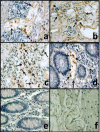Transcript levels of Toll-Like Receptors 5, 8 and 9 correlate with inflammatory activity in Ulcerative Colitis
- PMID: 22185629
- PMCID: PMC3287145
- DOI: 10.1186/1471-230X-11-138
Transcript levels of Toll-Like Receptors 5, 8 and 9 correlate with inflammatory activity in Ulcerative Colitis
Abstract
Background: Dysregulation of innate immune response by Toll-Like Receptors (TLRs) is a key feature in Ulcerative Colitis (UC). Most studies have focused on TLR2, TLR3, and TLR4 participation in UC. However, few studies have explored other TLRs. Therefore, the aim of this study was to evaluate the mRNA profiles of TLR1 to 9 in colonic mucosa of UC patients, according to disease activity.
Methods: Colonic biopsies were taken from colon during colonoscopy in 51 patients with Ulcerative Colitis and 36 healthy controls. mRNA levels of TLR1 to 9, Tollip, inflammatory cytokines IL6 and TNF were assessed by RT-qPCR with hydrolysis probes. Characterization of TLR9 protein expression was performed by Immunohistochemistry.
Results: Toll-like receptors TLR8, TLR9, and IL6 mRNA levels were significantly higher in the colonic mucosa from UC patients (both quiescent and active) as compared to healthy individuals (p < 0.04). In the UC patients group the TLR2, TLR4, TLR8 and TLR9 mRNA levels were found to be significantly lower in patients with quiescent disease, as compared to those with active disease (p < 0.05), whereas TLR5 showed a trend (p = 0.06). IL6 and TNF mRNA levels were significantly higher in the presence of active disease and help to discriminate between quiescent and active disease (p < 0.05). Also, IL6 and TNF mRNA positively correlate with TLRs mRNA with the exception for TLR3, with stronger correlations for TLR5, TLR8, and TLR9 (p < 0.0001). TLR9 protein expression was mainly in the lamina propria infiltrate.
Conclusions: This study demonstrates that TLR2, TLR4, TLR8, and TLR9 expression increases in active UC patients, and that the mRNA levels positively correlate with the severity of intestinal inflammation as well as with inflammatory cytokines.
Figures



Similar articles
-
Expression profile of Toll‑like receptors in human breast cancer.Mol Med Rep. 2020 Feb;21(2):786-794. doi: 10.3892/mmr.2019.10853. Epub 2019 Nov 26. Mol Med Rep. 2020. PMID: 31789409 Free PMC article.
-
Expression and implication of toll-like receptors TLR2, TLR4 and TLR9 in colonic mucosa of patients with ulcerative colitis.J Huazhong Univ Sci Technolog Med Sci. 2014 Oct;34(5):785-790. doi: 10.1007/s11596-014-1353-6. Epub 2014 Oct 16. J Huazhong Univ Sci Technolog Med Sci. 2014. PMID: 25318894
-
Expression and distribution of Toll-like receptors in the brain during murine neurocysticercosis.J Neuroimmunol. 2006 Dec;181(1-2):46-56. doi: 10.1016/j.jneuroim.2006.07.019. Epub 2006 Sep 29. J Neuroimmunol. 2006. PMID: 17011049 Free PMC article.
-
Association of TLR1, TLR2, TLR4, TLR6, and TIRAP polymorphisms with disease susceptibility.Immunol Res. 2015 Jun;62(2):234-52. doi: 10.1007/s12026-015-8640-6. Immunol Res. 2015. PMID: 25784622 Review.
-
The Role of Toll-like Receptors in Esophageal Cancer.Anticancer Res. 2022 Jun;42(6):2813-2818. doi: 10.21873/anticanres.15762. Anticancer Res. 2022. PMID: 35641301 Review.
Cited by
-
TLR9 induces colitis-associated colorectal carcinogenesis by regulating NF-κB expression levels.Oncol Lett. 2020 Oct;20(4):110. doi: 10.3892/ol.2020.11971. Epub 2020 Aug 12. Oncol Lett. 2020. PMID: 32863923 Free PMC article.
-
Topical Therapy with Antisense Tumor Necrosis Factor Alpha Using Novel β-Glucan-Based Drug Delivery System Ameliorates Intestinal Inflammation.Int J Mol Sci. 2020 Jan 20;21(2):683. doi: 10.3390/ijms21020683. Int J Mol Sci. 2020. PMID: 31968666 Free PMC article.
-
Degradation of intestinal mRNA: a matter of treatment.World J Gastroenterol. 2015 Mar 28;21(12):3499-508. doi: 10.3748/wjg.v21.i12.3499. World J Gastroenterol. 2015. PMID: 25834314 Free PMC article.
-
Dietary Grape Seed Meal Bioactive Compounds Alleviate Epithelial Dysfunctions and Attenuates Inflammation in Colon of DSS-Treated Piglets.Foods. 2021 Mar 4;10(3):530. doi: 10.3390/foods10030530. Foods. 2021. PMID: 33806347 Free PMC article.
-
Pogostemon cablin Acts as a Key Regulator of NF-κB Signaling and Has a Potent Therapeutic Effect on Intestinal Mucosal Inflammation.Mediators Inflamm. 2025 Apr 28;2025:9000672. doi: 10.1155/mi/9000672. eCollection 2025. Mediators Inflamm. 2025. PMID: 40331148 Free PMC article. Review.
References
Publication types
MeSH terms
Substances
LinkOut - more resources
Full Text Sources
Other Literature Sources
Medical
Miscellaneous

